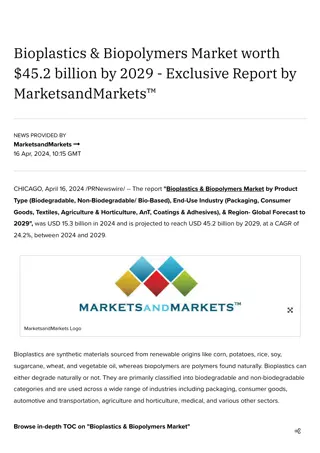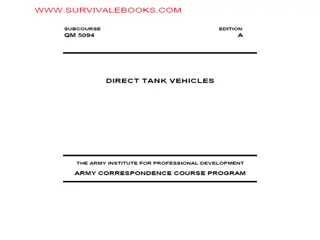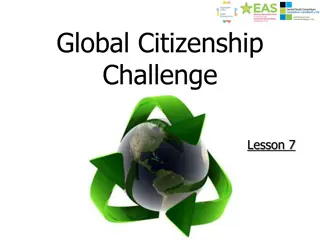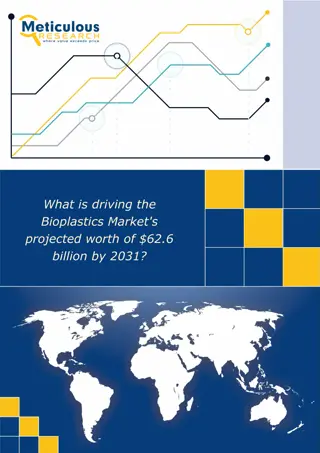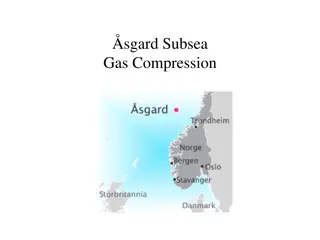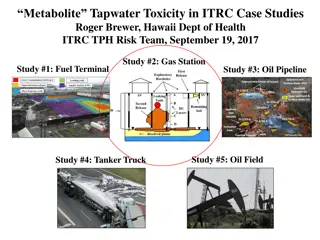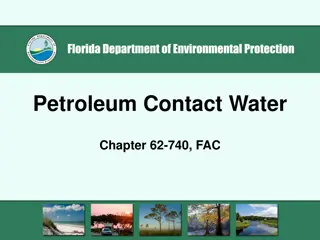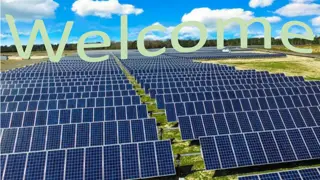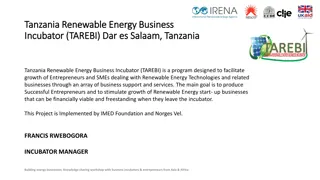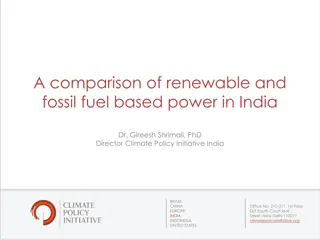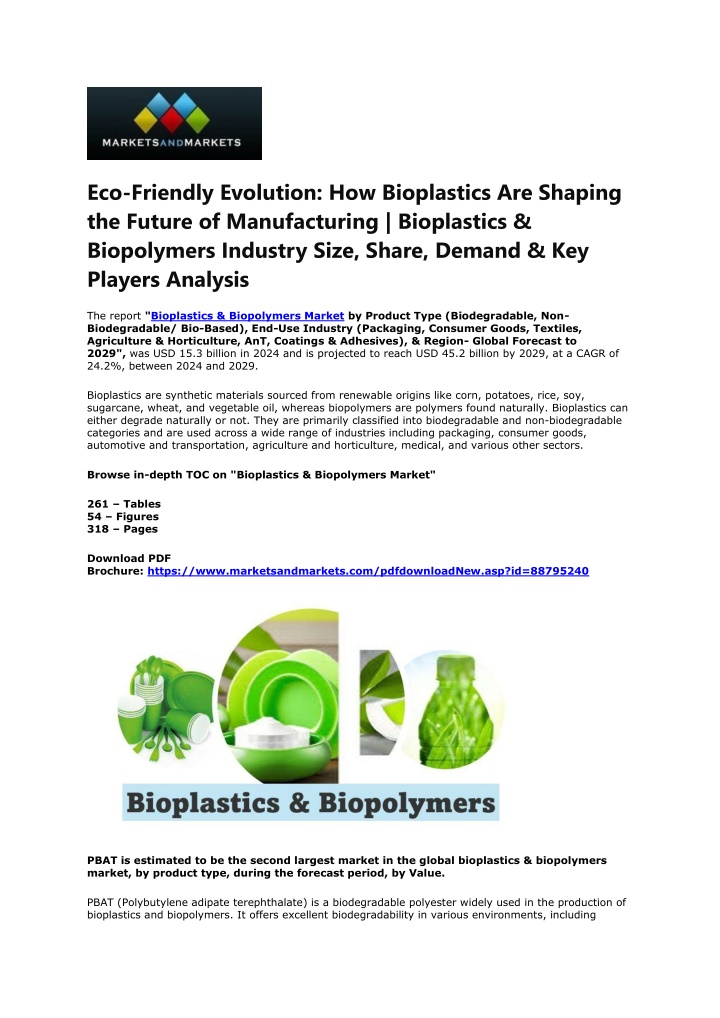
Beyond Petroleum: Bioplastics as a Renewable Alternative
Bioplastics are synthetic materials sourced from renewable origins like corn, potatoes, rice, soy, sugarcane, wheat, and vegetable oil, whereas biopolymers are polymers found naturally. Bioplastics can either degrade naturally or not. They are primarily classified into biodegradable and non-biodegradable categories and are used across a wide range of industries including packaging, consumer goods, automotive and transportation, agriculture and horticulture, medical, and various other sectors.
Download Presentation

Please find below an Image/Link to download the presentation.
The content on the website is provided AS IS for your information and personal use only. It may not be sold, licensed, or shared on other websites without obtaining consent from the author. If you encounter any issues during the download, it is possible that the publisher has removed the file from their server.
You are allowed to download the files provided on this website for personal or commercial use, subject to the condition that they are used lawfully. All files are the property of their respective owners.
The content on the website is provided AS IS for your information and personal use only. It may not be sold, licensed, or shared on other websites without obtaining consent from the author.
E N D
Presentation Transcript
Eco-Friendly Evolution: How Bioplastics Are Shaping the Future of Manufacturing | Bioplastics & Biopolymers Industry Size, Share, Demand & Key Players Analysis The report "Bioplastics & Biopolymers Market by Product Type (Biodegradable, Non- Biodegradable/ Bio-Based), End-Use Industry (Packaging, Consumer Goods, Textiles, Agriculture & Horticulture, AnT, Coatings & Adhesives), & Region- Global Forecast to 2029", was USD 15.3 billion in 2024 and is projected to reach USD 45.2 billion by 2029, at a CAGR of 24.2%, between 2024 and 2029. Bioplastics are synthetic materials sourced from renewable origins like corn, potatoes, rice, soy, sugarcane, wheat, and vegetable oil, whereas biopolymers are polymers found naturally. Bioplastics can either degrade naturally or not. They are primarily classified into biodegradable and non-biodegradable categories and are used across a wide range of industries including packaging, consumer goods, automotive and transportation, agriculture and horticulture, medical, and various other sectors. Browse in-depth TOC on "Bioplastics & Biopolymers Market" 261 Tables 54 Figures 318 Pages Download PDF Brochure: https://www.marketsandmarkets.com/pdfdownloadNew.asp?id=88795240 PBAT is estimated to be the second largest market in the global bioplastics & biopolymers market, by product type, during the forecast period, by Value. PBAT (Polybutylene adipate terephthalate) is a biodegradable polyester widely used in the production of bioplastics and biopolymers. It offers excellent biodegradability in various environments, including
industrial composting facilities and natural soil conditions. PBAT is commonly used as a component in blends with other biodegradable polymers to improve mechanical properties and enhance the overall performance of bioplastic materials. Its versatility, along with its ability to break down into environmentally friendly byproducts, makes PBAT a valuable ingredient in the development of sustainable packaging, agricultural films, disposable utensils, and other biodegradable products. As the demand for eco-friendly alternatives to traditional plastics grows, PBAT continues to play a crucial role in advancing the bioplastics and biopolymers industry. Sugarcane/Sugar beet to be the largest market in the global bioplastics & biopolymers market during 2024 to 2029, by value. Sugarcane and sugar beet serve as vital sources of raw materials for bioplastics and biopolymers, offering abundant stores of fermentable sugars essential for producing eco-friendly plastics like polylactic acid (PLA) and polyhydroxyalkanoates (PHA). Their widespread cultivation globally provides a sustainable and renewable feedstock for biopolymer manufacturing, without competing with food crops for agricultural land. Additionally, their growth contributes to carbon sequestration, enhancing the environmental profile of bioplastics derived from these sources by mitigating carbon emissions. Leveraging sugarcane and sugar beet underscores the shift towards sustainable practices in the plastics industry, promoting environmental stewardship and reducing reliance on fossil fuels. Request Sample Pages: https://www.marketsandmarkets.com/requestsampleNew.asp?id=88795240 Consumer goods is estimated to be the second-largest end-use industry, in 2024. Consumer goods encompasses a wide range of products including packaging, disposable cutlery, bottles, bags, and various other items used in everyday life. The demand for sustainable packaging solutions is particularly high in the consumer goods industry due to increasing environmental awareness among consumers and regulatory pressures to reduce plastic waste. Bioplastics offer a promising alternative as they are derived from renewable resources and can be biodegradable, thereby addressing concerns related to traditional plastics. As a result, many companies in the consumer goods sector are incorporating bioplastics into their product packaging and manufacturing processes to reduce their environmental footprint and meet the evolving preferences of eco-conscious consumers. Europe accounted for third largest region, by value, during the forecast period. The bioplastics and biopolymers market in Europe is experiencing growth and innovation. With increasing awareness of environmental issues and sustainable practices, there's a notable emphasis on the adoption of bioplastics derived from renewable sources. European countries are investing in research and development to expand the application of bioplastics across various industries including packaging,
consumer goods, automotive, agriculture, and more. Additionally, stringent regulations and initiatives promoting the use of eco-friendly materials are driving the demand for bioplastics and biopolymers in the region. The key companies producing biodegradable plastics in Europe include BASF (Germany), TotalEnergies Corbion PLA (Netherlands), Biome Bioplastics (UK), and Bio-On (Italy). Get 10% Customization on this Report: https://www.marketsandmarkets.com/requestCustomizationNew.asp?id=88795240 Bioplastics & Biopolymers Market Key Players NatureWorks LLC (US), Braskem (Brazil), BASF SE (Germany), TotalEnergies Corbion (Netherlands), Novamont S.P.A (Italy), Biome Bioplastics Limited (UK), Mitsubishi Chemical Group Corporation (Japan), Biotec Biologische Naturverpackungen GmbH & Co. (Germany), Plantic Technologies Limited (Australia), and Toray Industries, Inc. (Japan) are the key players in the bioplastics & biopolymers market. BASF SE, a prominent chemical company, operates across six business segments: chemicals, materials, industrial solutions, surface technologies, nutrition & care, and agricultural solutions. It offers biodegradable plastics through its materials segment and conducts research in process research & chemical engineering, advanced materials & systems research, and bioscience research. Serving over 90,000 customers globally, BASF holds a top-three market position in approximately 30% of its active business areas. With six Verbund sites and 232 additional production sites worldwide, the company operates extensively across Europe, Asia Pacific, North America, South America, Central America, and the Middle East & Africa.

